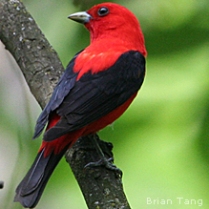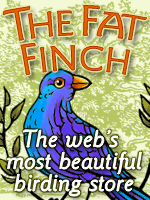From the National Wildlife Federation
 From the American Bird Conservancy: top 10 things you can do in your home or yard to help declining migratory birds
From the American Bird Conservancy: top 10 things you can do in your home or yard to help declining migratory birds
The American Bird Conservancy (ABC) often gets asked how people can help birds during this time of year. Toward that end, ABC has identified the top ten things people can do to aid or protect migratory birds in their homes and yards.
1. Keep your cat indoors—this is best for your cat as well as the birds, as indoor cats live an average of three to seven times longer. Even well fed cats kill birds, and bells on cats don’t effectively warn birds of cat strikes. For more information, go to http://www.abcbirds.org/cats.
2. Prevent birds from hitting your windows by using a variety of treatments to the glass on your home—check out ABC’s tips at http://www.abcbirds.org/abcprograms/policy/collisions/glass.html
3. Eliminate pesticides from your yard—even those pesticides that are not directly toxic to birds can pollute waterways and reduce insects that birds rely on for food.
4. Create backyard habitat—if you have a larger yard, create a diverse landscape by planting native grasses, flowers, and shrubs that attract native birds. You will be rewarded by their beauty and song, and will have fewer insect pests as a result.
5. Donate old birdwatching equipment such as binoculars or spotting scopes to local birdwatching groups—they can get them to schools or biologists in other countries who may not have the resources they need.
6. Reduce your carbon footprint—use a hand-pushed or electric lawnmower, carpool, use low energy bulbs and Energy Star appliances. Contact your energy supplier and ask them about purchasing your energy from renewable sources.
7. Buy organic food and drink shade-grown coffee—increasing the market for produce grown without the use of pesticides, which can be toxic to birds and other animals, will reduce the use of these hazardous chemicals in the U.S. and overseas. Shade coffee plantations maintain large trees that provide essential habitat for wintering songbirds.
8. Keep feeders and bird baths clean to avoid disease and prevent mosquitoes from breeding.
9. Support bird friendly legislation both locally and in the U.S. Congress.
10. Join a bird conservation group—learn more about birds and support important conservation work.
According to ABC, birds need our help now more than ever. In addition to the ongoing threat of loss of habitat that is becoming magnified by global warming, millions of birds are directly killed due to a number of different human-related causes.
Scientists estimate that 300 million to 1 billion birds die each year from collisions with buildings. Up to 50 million die from encounters with communication towers. At least 11 million die from car strikes. Another 1 million may die each day from attacks by cats left outdoors.
Some of these deaths occur year-round but many occur during the peak spring and fall migrations. Some studies suggest that perhaps as many as half of all migrating birds do not make it back to spring and summer grounds, succumbing to various threats on either end of the journey.
“Protecting and helping birds is not only the right thing to do, it is also good for the economy and the future of our environment. Birds are invaluable as controllers of insect pests and as pollinators of crops, and also generate tremendous economic revenues through the pastimes of bird feeding and birdwatching,” says ABC President George Fenwick.
A recent federal government study reports that over 20 percent of the U.S. population – 48 million people – participates in birdwatching. Of that total, about 42 percent (20 million people) actually travel to see birds. Birders spend about $36 billion annually in pursuit of their pastime. The top five birdwatching states by percentage of total population are: Montana (40%); Maine (39%); Vermont (38%); Minnesota (33%); and Iowa (33%).




